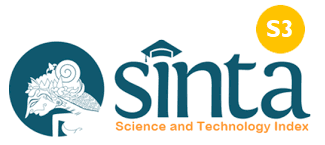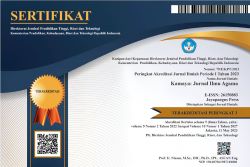Akseptabilitas Terjemahan Kumpulan Cerita Anak Oleh Mahasiswa Bahasa Dan Satra Jawa UNNES
DOI:
https://doi.org/10.37329/kamaya.v8i2.3910Keywords:
akseptabilitas, terjemahan, sastra anak, mahasiswaAbstract
With the aim of presenting alternative children's stories in Javanese, Javanese Language and Literature students translated children's stories from several stories by Javanese literary writers. The purpose of this study was to analyze the acceptability of students' translation results for children's literature in Javanese. The research method used a qualitative approach, a case study method with translation assessment criteria from Rochayah Machali with four aspects. The data source was the results of student translations consisting of 12 children's stories with various dialects. Data analysis by Cresswell with six stages. The results of the study showed that in the translation results seen from several aspects: 1) the accuracy of meaning production, there were several transpositions because there were adjustments to the TL context, but modulation was not found because the majority of translations were word-by-word, idioms were found in several stories and were correct in their translation, semantic aspects were in accordance with conventions, pragmatic meanings were sequential even though some words did not have equivalents in the TL; 2) reasonableness of expression, some stories were translated naturally, some were still stiff; 3) terminology, it can be said that 70% of the 12 stories used dialect terms correctly and clearly, but the rest were lacking. 4) spelling, the majority of errors in punctuation, typos, and typical Javanese spelling. Based on these results, it was concluded that 8 stories were categorized as good translations (C) and 4 stories were categorized as fair translations (D).
References
Fadhiluddin, M. (2020). Akseptabilitas Hasil Terjemahan Bentuk Funktionsverbgefüge oleh Mahasiswa Jurusan Sastra Jerman, Universitas Negeri Malang. Journal Deutsch Als Fremdsprache in Indonesia, 4(1), 21–30.
Hayati, Y. (2015). Menuliskan (Kembali) Sastra Anak dalam Sejarah Sastra Indonesia. Dalam Sastra Kita: Dulu, Kini, dan Nanti (hlm. 78–94). Prosiding Seminar Internasional Sastra Bandung 2015, Balai Bahasa Provinsi Jawa Barat, Bandung, 7–8 Oktober 2015.
Krissandi, A. D. S., dkk. (2018). Sastra Anak: Media Pembelajaran Bahasa Anak. Yogyakarta: Bakul Buku Indonesia.
Kurnia, A. (2022). Seni Penerjemahan Sastra: Panduan, Gagasan, dan Pengalaman. Yogyakarta: Diva Press.
Larson, M. L. (1984). Meaning-Based Translation: A Guide to Cross-Language Equivalence. Lanham, MD: University Press of America.
Machali, R. (2009). Pedoman Bagi Penerjemah: Panduan Lengkap Bagi Anda yang Ingin Menjadi Penerjemah Profesional. Bandung: Mizan Media Utama.
Nababan, M. R. (2003). Teori Menerjemah Bahasa. Yogyakarta: Pustaka Pelajar.
Newmark, P. (1988). A Text Book of Translation. Herfordshire: Prentice Hall.
Nida, E. A., & Taber, C. R. (1982). The Theory and Practice of Translation. Leiden: E. J. Brill.
Nur Hasan, L., & Pairin, U. (2021). Pendidikan Integritas dalam Wacan Bocah Majalah Panjebar Semangat: Kajian Struktural Teks Sastra Anak Berbahasa Jawa. Jurnal Ibriez: Jurnal Kependidikan Dasar Islam Berbasis Sains, 6(2), 145–164.
Nurgiyantoro, B. (2004). Sastra Anak: Persoalan Genre. Humaniora, 16(2), 107–122.
Rankema, J. (1993). Discourse Studies: An Introductory Textbook. Amsterdam: John Benjamins Publishing Company.
Ridlo, U. (2023). Metode Penelitian Studi Kasus: Teori dan Praktik. Jakarta: Publica Institute.
Rosyidah, dkk. (2017). Akseptabilitas Terjemahan Dongeng Haensel and Gretel. Bahasa dan Seni, 45(1), 64–75.
Setyowati, S., dkk. (2023). Memahami Fenomenologi, Etnografi, Studi Kasus, dan Metode Kombinasi dalam Jagad Metode Riset. Riau: Sotplus Publisher.
Widati, S. (2001). Ikhtisar Perkembangan Sastra Jawa Modern Periode Prakemerdekaan. Yogyakarta: Gadjah Mada University Press.
Wuryantoro, A. (2018). Pengantar Penerjemahan. Yogyakarta: Budi Utama.
Zoetmulder, P. J. (1983). Kalangwan: Sastra Jawa Kuno Selayang Pandang. Jakarta: Djambatan.
Downloads
Published
How to Cite
Issue
Section
License
Copyright (c) 2025 Kamaya: Jurnal Ilmu Agama

This work is licensed under a Creative Commons Attribution-ShareAlike 4.0 International License.
An author who publishes in the Kamaya : Jurnal Ilmu Agama agrees to the following terms:
- Author retains the copyright and grants the journal the right of first publication of the work simultaneously licensed under the Creative Commons Attribution-ShareAlike 4.0 License that allows others to share the work with an acknowledgement of the work's authorship and initial publication in this journal
- Author is able to enter into separate, additional contractual arrangements for the non-exclusive distribution of the journal's published version of the work (e.g., post it to an institutional repository or publish it in a book) with the acknowledgement of its initial publication in this journal.
- Author is permitted and encouraged to post his/her work online (e.g., in institutional repositories or on their website) prior to and during the submission process, as it can lead to productive exchanges, as well as earlier and greater citation of the published work (See The Effect of Open Access).
Read more about the Creative Commons Attribution-ShareAlike 4.0 Licence here: https://creativecommons.org/licenses/by-sa/4.0/.





